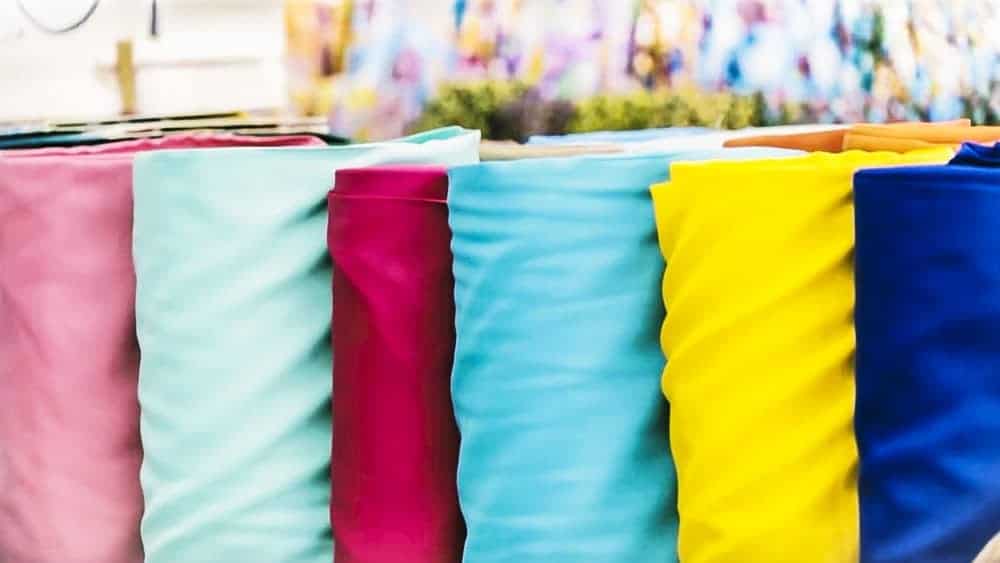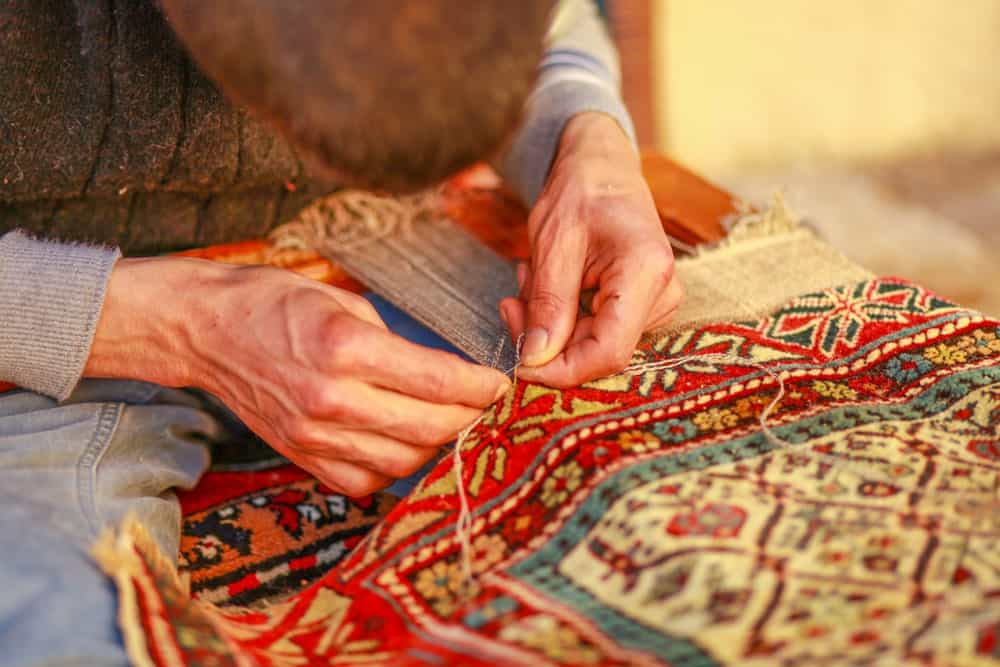There are few fabrics other than silk that go back further in history or that make such intriguing designs. Brocade is one of them. Originating in ancient China, it was worn by the gods and royalty. Today's brides wear brocaded satin wedding gowns. Men and women wear brocade evening wear.

I remember visiting my great aunt as a child, sitting perfectly still and lady-like on her teal brocade Empire-style sofa. I longed to run my hand over the rolled back and arms but was constantly told not to touch anything. Since those days, I’ve wanted such a sofa, but haven’t been lucky enough to find one.
Brocade is an elegant, rich fabric used in formal wear, special jackets, bridal gowns, costumes, and upholstery for furniture. Depending on the base of the fabric, brocade has a sheen and a texture that is uniquely its own. There are different types of brocade fabric, and we’ll tell you all about them.
Table of Contents
- A Word About Jacquard Brocade
- Brocade Has A Fascinating History
- A Word About Weft, Warp, And Weave
- Types Of Brocade Fabric
- Where To Buy Brocade Fabric
- FAQs
A Word About Jacquard Brocade
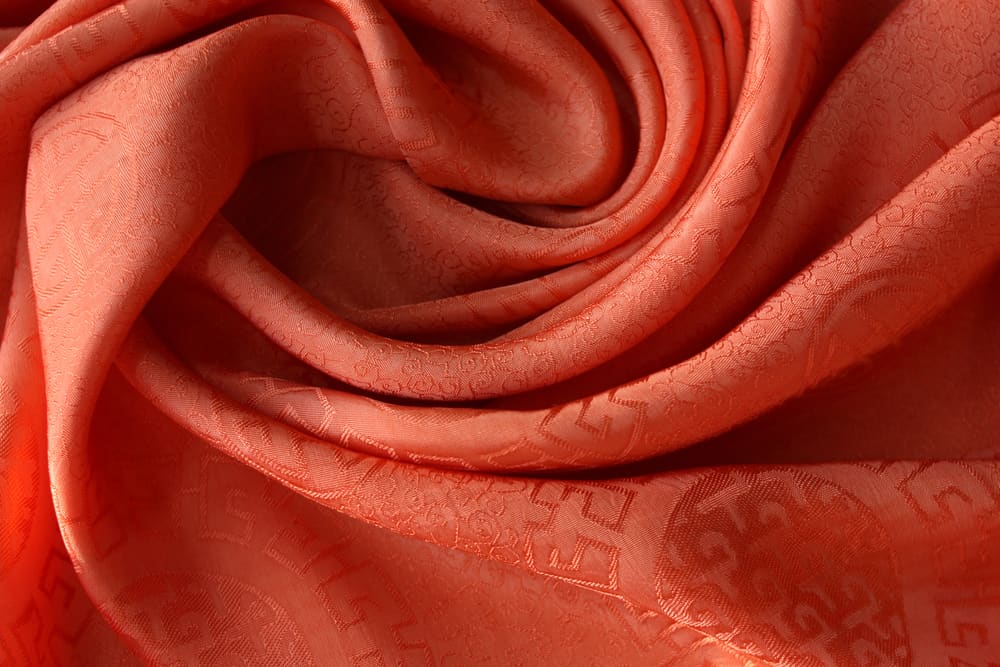
That disposable lighter you use? The disposable pen you use? They’re called Bic, and they were invented by Marcel Bich. That’s one example of an invention becoming the popular name of the inventor. The same is true of jacquard fabric.
Up until the beginning of the 19th century, brocade fabric was woven on a handloom. It produced a beautiful pattern. Then Joseph Marie Jacquard invented the jacquard loom which produced complex patterns without extra work. Since then, brocades have been woven on this jacquard loom.
Now, about that name: it’s safe to call a brocade fabric a jacquard fabric, but it’s not safe to call all jacquard textiles brocade. That’s because jacquard looms produce other weaves such as damask, tapestry, and brocatelle. These consist of different thicknesses, patterns, and reversibility. So just because brocade is woven on a jacquard loom doesn’t make it jacquard nor make jacquard brocade.
Brocade Has A Fascinating History
In the beginning, China was a secretive and enclosed place. No one got in. No one got out. Thus, silk was grown there and used for a vast number of products including clothing. Silk brocade was usually reserved for royalty and the upper echelons of society. This state of affairs lasted from approximately 475 BCE until the first few years of the Common Era when China opened its doors to trade.
This occasioned those from Asia to “borrow” the secret of silk-making, so they could establish trade of their own. Byzantium successfully brought back the secret of silk-making. They established their own trade over the Eurasian continents.
In the blink of an eye, Byzantium became a prolific producer of silk fabric including brocade. Byzantium then shut out China as a silk and brocade producer, and this situation remained until the end of the Byzantine Empire and well into the Middle Ages.
Brocade remained the go-to fabric for the nobility with Byzantium supplying three-quarters of the Eurasian continent and China supplying East Asia. Other European countries got on the bandwagon, with Italy a major designer in the Renaissance period. Today, the fabric is produced in China and Australia.
When the jacquard loom came along, it mass-produced brocade fabric. The price went down, so the textile was used for everything from upscale clothing to draperies to upholstery for furnishings. Today’s fashion designers aren’t interested in brocade, but it can still be found in homewares.
A Word About Weft, Warp, And Weave

No, we’re not going to the fabric store at warp speed, Mr. Warf. Those are terms for which direction the threads are woven. The warp is a vertical thread, while the weft is a horizontal thread. Picture in your mind one of those child’s potholder weaving things. With me so far?
The weft or horizontal thread can go from selvage to selvage or from side to side of the base cloth. Patterns are added by hand along with additional wefts or horizontal threads. This type of weave is called discontinuous. A continuous weave is a brocade with loose threads hanging on the back of the textile.
You’ll read about satin weaves in the list of types of brocade fabric. There are other types of weave, though. Plain weave fabric is woven with one weft thread over and under one warp thread and vice versa. An example of plain weave fabric would be bed linens.
Twill isn’t actually a type of fabric; it’s a weave itself. It forms an interesting diagonal pattern by weaving one weft thread over one or two warp threads and then passing under two or more warp threads. There’s a skip or offset row next to the row to form the diagonal pattern.
A damask weave is notable for being created on a jacquard loom. It’s a cotton fabric with contrasting lustrous patterns. The shine is accomplished using a satin weave along with twill or plain weave. The fabric is reversible, meaning no threads are left hanging on the backside.
A jacquard weave is done on a jacquard loom. The warp thread is lifted from the other threads to form the intended pattern. Thus, the pattern is woven into the fabric.
Types Of Brocade Fabric
Brocade types are dependent upon the thread used to make them. Silk and cotton brocade is called silk and cotton brocade while incorporating metal threads into the textile is called zari. So, here are the types of brocade fabric.
Silk Brocade
Click image for more info
Velvet Brocade
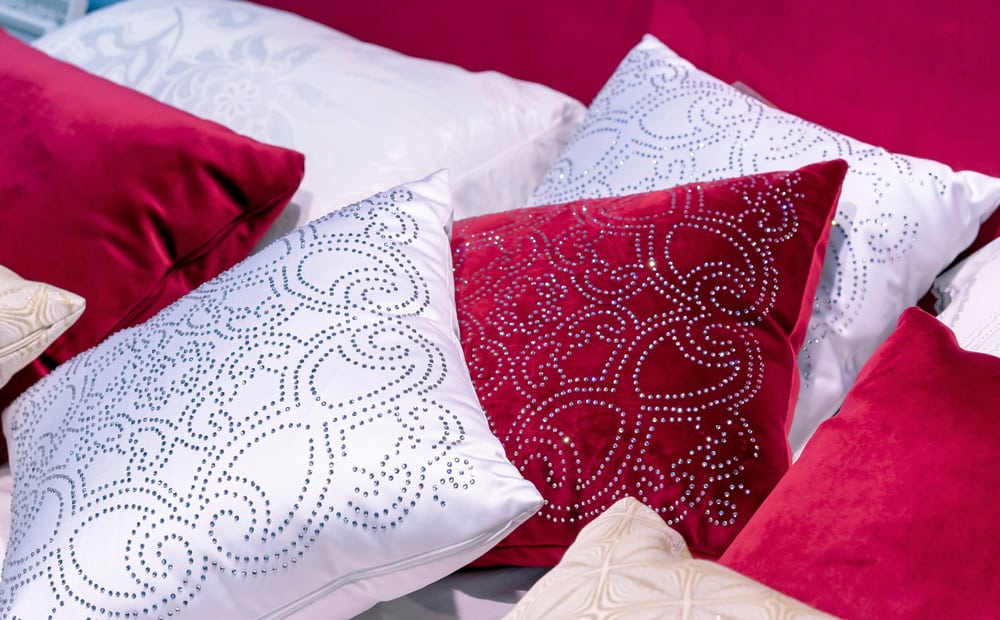
Velvet brocade is possibly one of the most intricate fabrics on the planet. The velvet must be processed first, and then it has to be brocaded. That’s not all. The velvet has two, count ’em, two warps, and that’s before it’s brocaded. Here’s how it works.
Velvet is all about the pile or the top of the fabric that’s so soft. However, it’s the thread you choose with which to weave that makes or breaks a velvet. What we mean by that is that cotton velvet or synthetic velvet is still soft. It’s the silk thread, though, that makes the most unbelievably soft velvet.
First, the base of the cloth is woven which is called the ground warp. It’s woven with the weft. The second warp is called the pile warp. The threads wrap around special parts of the loom to form the soft top of velvet fabric. It’s this pile warp that is woven with the brocade pattern. It’s all done within these two steps.
Satin Brocade

As you can see in the picture, brocading can be woven into any fabric at all. Here, the floral pattern is done on lustrous white satin. However, the end product isn’t the focus. The weave itself is called satin weave. It comprises four or another amount of warp threads over one weft thread or the other way around with four or any number of weft threads over one warp thread. The brocade comes in with one of the warp or weft threads forming the brocade pattern.
Cotton Brocade
Click image for more info
After looms process the cotton into yarn to be woven into cloth, the resulting textile is pre-shrunk, dyed, bleached, or printed. The fabric is then sent to factories to be cut and sewn into clothing. It’s when the cotton is woven into cloth that it’s woven with brocade patterns.
Wool Brocade
As you’ve read, any fabric can be made into brocade, and that includes wool. The finest brocades are made of silk and wool mixtures, and only the softest and finest of wool threads will do. The thread is woven into a warp and a weft, with the brocade design woven into it. The resulting textile is soft, durable, and stunningly beautiful.
Synthetic Brocade
These man-made textiles include polyester, nylon, rayon, acrylic, acetate, latex, and spandex. The brocade pattern is woven into the textile during polymerization of the synthetic fibers into cloth.
Himru Brocade
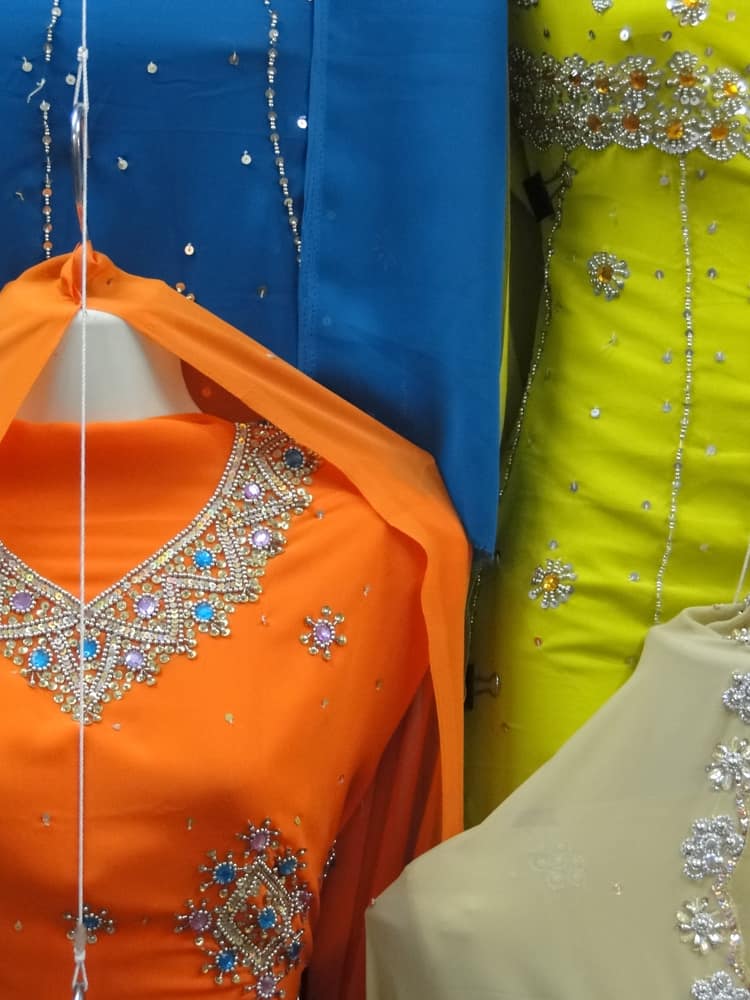
Himroo is a Persian brocade weave made of silk and cotton. Largely grown in India and used for clothing there, Himru was originally woven with gold and silver threads and worn by the royal family.
When people think of Indian clothing, they picture raven-haired women in stunningly beautiful sarees. The bright, jewel colors and the intricate patterns in gold and silver have made women all over the globe want one.
Banaras was an ancient city still lending its name to its most fabulous product: Banarasi brocade fabric made into Banarasi brocade sarees. Persian patterns are still used to this day to distinguish the sarees, although the silk and cotton are sourced from India.
Zari Brocade
Click image for more info
Zari is the ancient art of making pure gold and silver threads wrapped around silk threads (or other threads like synthetics or cotton.) The metals are flattened and then wrapped around the silk thread. Thus, the fabric woven from it gleams. The textile is then brocaded with images of birds, flowers, geometric shapes, and more. Zari brocade was originally worn by gods, royalty, and the nobility.
Damask Brocade
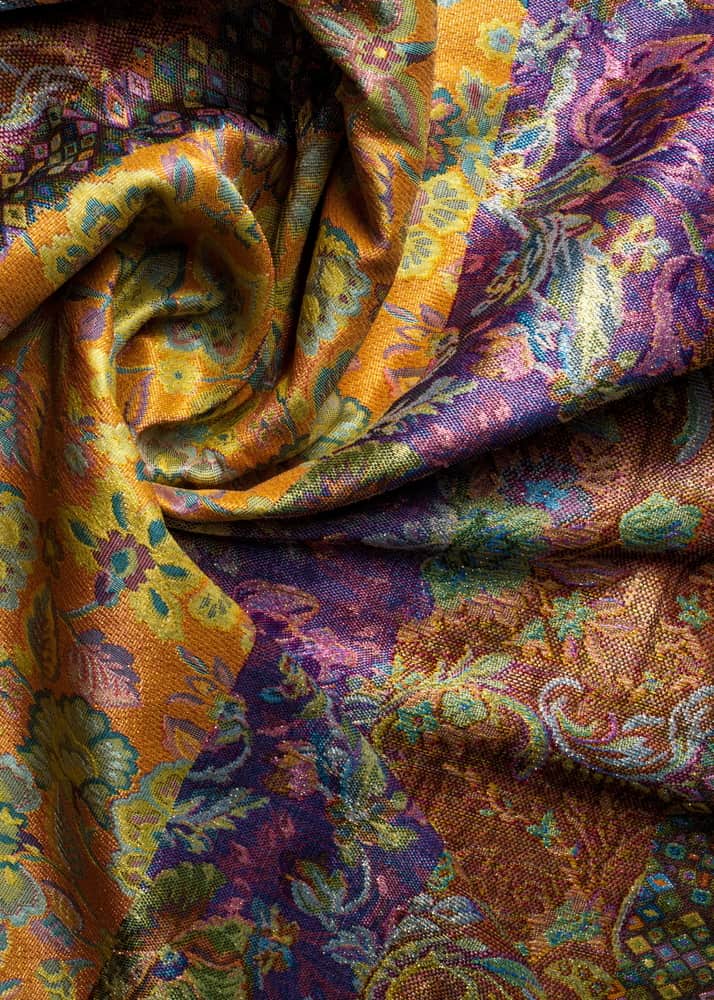
Damask is a weave whose patterns can be woven into silk, cotton, wool, linen, or synthetic threads. The pattern is achieved using a satin weave against a background of plain or twill weave. Only one warp and the weft thread are used in the damask. Damask is thick, heavy, and reversible, but it’s also quite durable.
Tapestry Brocade
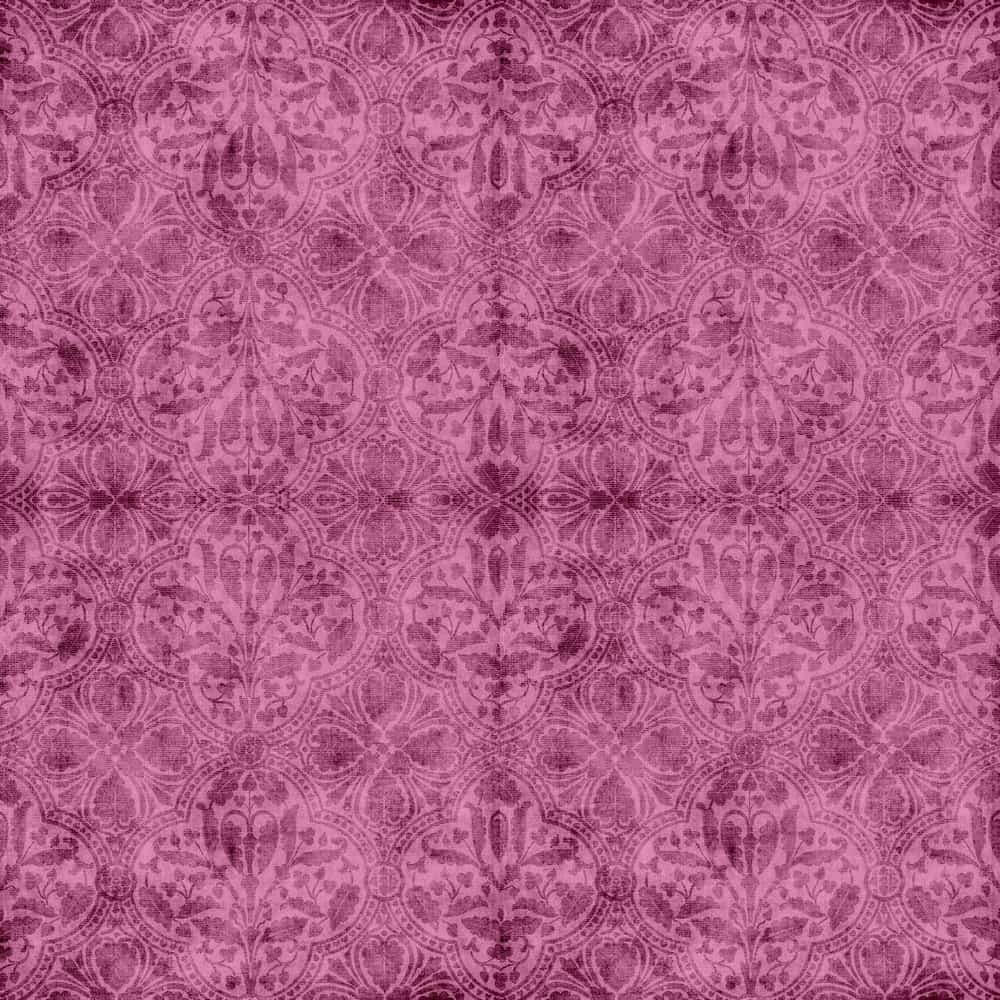
The word tapestry conjures up mental pictures of vast, colorful wall hangings portraying valor in battle, family history, or the joining of two families and their histories in a marriage forming a dynasty. The history of tapestries goes back to ancient Egypt when they were found in the tombs of the pharaohs. Tapestries were also woven in Western Europe from about the same time on up to the present.
Today’s weavers, though, have bowed before the computer-aided program. The computer now controls each single warp yarn and weft yarn in the pattern. Jacquard looms now produce tapestry brocade fabric with complex patterns and pictures. The result, however, is just as stunning.
Brocatelle Brocade
I couldn’t find an appropriate picture as an illustration, but this should give you a good idea. Or, the next time you see a child’s T-shirt printed with a character that’s puffed up and raised from the fabric of the shirt, you’re looking at brocatelle. It relates to a brocade like this.
A warp of silk and linen is double woven against a silk and linen double weave weft. The puffy look of the pattern is created using tension in the weaving of the weft. The resulting brocade pattern looks embossed.
Where To Buy Brocade Fabric
Any department store with a sewing department sells brocade fabric. Think Walmart. Dedicated fabric stores like JoAnn Fabrics or Fabric Wholesalers carry brocade fabric. Online stores selling it are endless such as Wayfair, Etsy, Amazon, and Online Fabric Store.
FAQs
Where Is Brocade Fabric Produced?
China still weaves brocade fabrics today, but the countries producing the most of them are the Czech Republic, Austria, and Germany. The African country Mali does a resounding job of producing it. India produces and weaves its own brocade fabrics. France, Italy, and the British Empire produce brocade.
Can You Wash Brocade Fabric?
The care and cleaning of brocade fabrics depend on the type of threads used in its weaving. Washing machines are not recommended. The thrashing about of the agitator can damage the material. The differences in the formulae of cleaning detergents, even if they say they’re mild, can damage the fabric. The manipulations in hand-washing can be too much for the textile. Just to be safe, dry-clean your brocade.
How Many Types Of Banarasi Sarees Are There?
The ancient and holy city of Banarasi, now known as Varanasi, produced the best silk sarees. Banarasi sarees are well known for their splashy, intricate designs on jewel color fabrics in gold and silver threads or zari. There are four types of Banarasi sarees:
- Katan. Pure silk threads are woven into fabric. The fabric is then brocaded with imaginative patterns. Katan is the most popular choice for weddings and other high society functions.
- Shattir. These, too, are made of silk, but it’s the intricate design that makes the fabric heavy. Also worn for weddings and formal events.
- Organza. Organza is a feathery-light, sheer, plain weave fabric. The fabric is then brocaded with its pattern in warp and weft using silk threads and zari or silver and gold threads wrapped around the silk.
- Georgette. Georgette is a light crêpe fabric composed of pure silk in a plain weave. The crêpe yarn is twisted in an “s” pattern as well as a “z” pattern, which means the yarns are going in opposing directions. This makes the fabric crinkle, one of the most recognizable properties of georgette. The pattern is then brocaded onto the crêpe fabric.
How Do You Clean Brocade Upholstery?
No matter the base material of the brocade upholstery (cotton, silk, synthetic, etc., ) the textile can be damaged by harsh chemicals. Professional cleaning is recommended. Steam cleaning is not, because the hot water could damage the textile.
However, if your toddler has spilled her juice on your brocade sofa, fetch a cotton ball and a bottle of rubbing alcohol. Find a hidden spot on the sofa for a test. Wet the cotton ball. Just barely touch it to the sofa. If the color comes off onto the cotton ball, let it sit for a few minutes to see if there’s damage to the textile.
If there is no damage, wet a clean cotton ball with the rubbing alcohol. Touch the cotton ball to the stain. Wait to see if any damage has occurred to the sofa. If not, then apply the alcohol on a clean cotton ball until the stain is gone. If this doesn’t work, then you’ll need to call in the pros.
How Should Brocade Furnishings Be Maintained?
Lots of brocade furnishings are antiques, which require exacting and gentle care for the longevity of the piece. Several factors define the care and maintenance of your brocade fabrics:
- Relative humidity. A room that’s too humid can make the wood expand and contract. The fabric itself can become wet. The ideal humidity is between 45 and 55 percent. Make sure your A/C and heat are at the correct humidity.
- Heat sources. The placement of your brocade furnishings is important to the longevity of the item. Keep your furnishings away from heat sources like vents, radiators, and fireplaces. These can damage your fabrics the same way too much humidity can.
- UV rays. The sun’s rays lighten the paint on the walls, the carpet, hardwood floors, as well as brocade furnishings. Place your furnishings away from direct sunlight.
- Pest infestations. If you see an entry or exit holes or piles of sawdust beneath or around your brocade furniture, then you have an infestation. Call the exterminator pronto.
- Cleaning the upholstery requires dry cleaning solutions such as dry foam and a foam sponge. Wet brocade takes up to nine hours to dry, and the water could damage the textile. If the fabric is dull or dusty, try very gently vacuuming it first. If it still looks less than perfect, call a professional to clean it.





